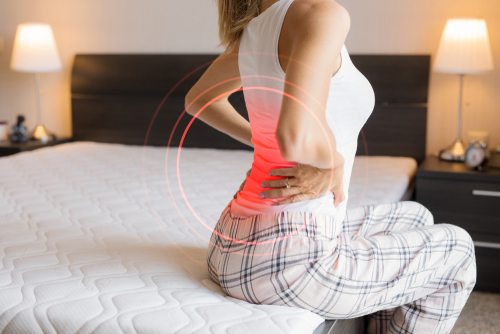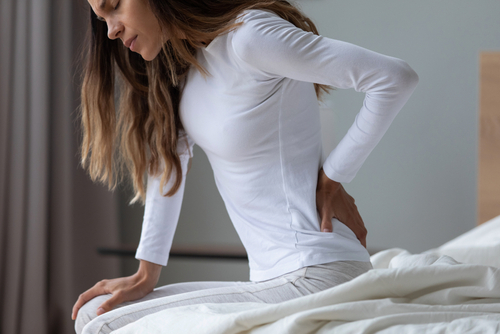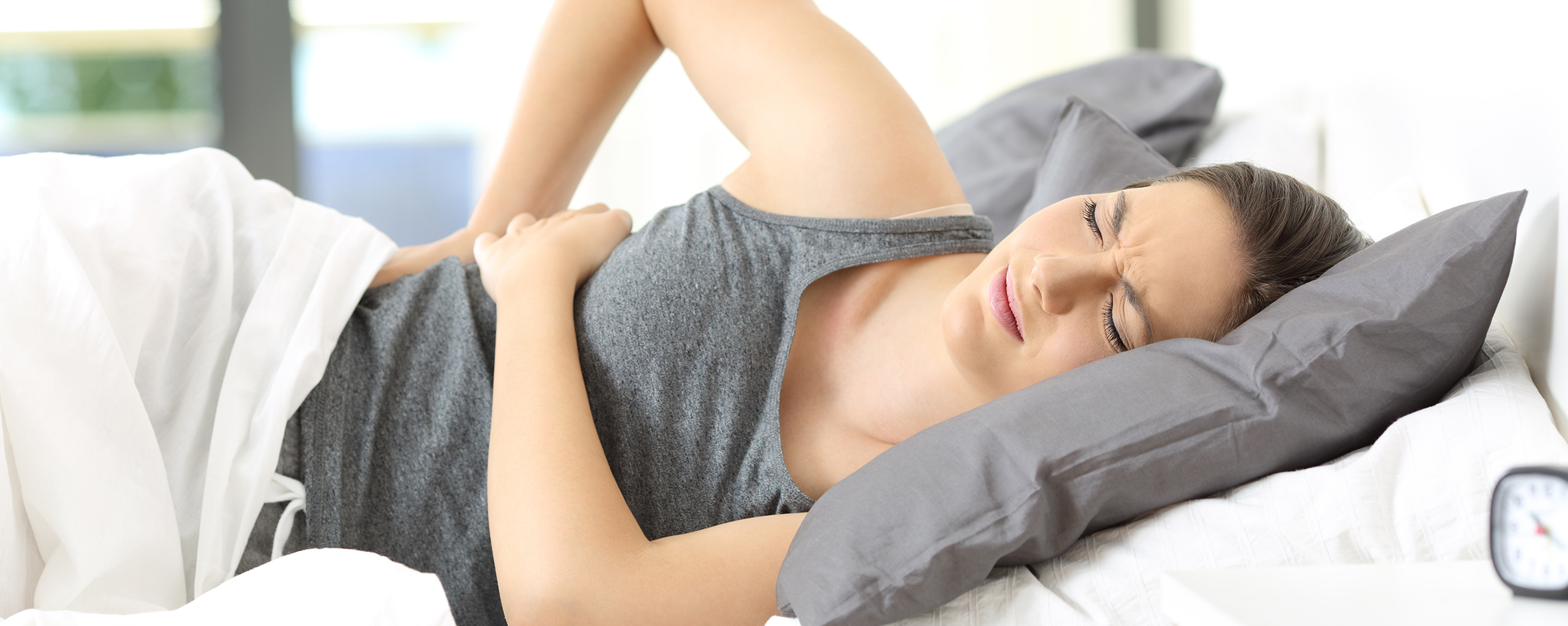If you’re experiencing acute or chronic pain, it may feel as though poor sleep is inevitable, and outside your control. The good news is that although sleep disturbance is very common, there are simple steps that you can take to improve sleep quality. There is good evidence that improving sleep can actually reduce the day to day symptoms of chronic pain, such as back pain and arthritis (Duo 2023).
What is pain?
Pain is a very individual experience – only the person in pain can say how painful something is. It has been defined as an unpleasant sensory and emotional experience associated with, or similar to, actual or potential tissue damage (IASP 2020).
We can feel acute pain in response to an injury, disease or overuse, often associated with inflammation. The pain comes on suddenly and acts like an alarm, and usually encourages us not to move that part of the body to avoid making things worse. Acute pain is short-lived.

In the UK, at least 1 in 6 of the population are thought to suffer from chronic pain, such as back pain or arthritis, which persists for more than 3 months ( Mills 2019). Chronic pain is a medical disorder, and is often linked to problems with physical functioning, cognition and emotional wellbeing. Chronic pain often persists without a known cause, other than disruption to the pain system, which alters how we detect and interpret pain.
We have a network of pain receptors and specialised nerve fibres which carry nerve signals to the brain via the spinal cord. Our interpretation of these pain signals can be influenced by a number of different factors, including the emotional centres in the brain. If we feel angry, depressed or anxious, our pain tends to be worse, whereas feeling positive can increase our ability to cope. Our environment, social support and thoughts about pain can therefore have a huge influence on how we experience pain.
Chronic pain can affect anyone, but risk factors include increasing age, being female, socioeconomic deprivation, low job satisfaction, smoking, obesity, harmful alcohol intake, sedentary behaviour, poor diet, poor mental health and poor sleep.
How common are sleep problems in people suffering from chronic pain?
Sleep problems are extremely common in people living with chronic pain, with over 70% reporting difficulty falling asleep, fragmented sleep or waking up unrefreshed ( Sun 2021). Studies have found that chronic pain is associated with less time spent asleep overall and, in particular, chronic less time spent in deep, slow wave sleep.
A recent review found high rates of sleep disorders in chronic pain, with insomnia (72%), Restless Legs Syndrome (32%), and obstructive sleep apnoea (32%) being the most common conditions (Mathias 2018).
Some studies suggest that as many as 50% of adults with insomnia experience chronic pain (Whale 2021). People who experience sleep problems and chronic pain are likely to have worse pain severity, greater disability, be less physically active and be at greater risk of poor mental health than those without disturbed sleep.
What’s the relationship between sleep and pain?
The relationship between sleep and pain is bidirectional; that is, pain can interfere with sleep, but sleep deprivation can also increase our experience of pain. In fact, some studies suggest that poor sleep has a stronger influence on chronic pain, than pain is a predictor of poor sleep (Husak 2020, Anderson & Holliday 2023).
In healthy people, experiments have found that sleep deprivation increases sensitivity and lowers tolerance to acute pain, such as when volunteers are asked to keep their hand in ice water for as long as possible. Other experiments have also found that when healthy people with no pain have their sleep restricted to 4.5 hours, and are woken up repeatedly, they report more spontaneous experiences of pain (Smith 2017). These changes in healthy people can be reversed by recovery sleep.
In patients awaiting surgery for joint replacements, sleep quality before the operation was a predictor of outcomes 3 months later (Luo 2019). Better sleep was associated with lower pain, greater range of motion and shorter length of postoperative stay, suggesting that improving sleep before surgery might be a helpful intervention to prepare for surgery.
According to one long term study which monitored volunteers for up to 22 years, people who reported having insomnia and short sleep for more than 10 years were at an especially high risk of experiencing recurrent back pain, whereas improvement in insomnia symptoms was associated with better pain outcomes (Norstoga 2022 )
Why are sleep and pain linked?
The mechanisms behind the links between sleep and pain are still being explored by scientists, but there could be many factors at play, such as:
- Inflammation: slow wave sleep is usually when the body reduces inflammation. Inflammatory cells are the body’s natural reaction to infection or injury, but persistent or chronic inflammation can cause pain and low mood.
- Disrupted circadian rhythms: sleep disruption often leads to irregular sleep-wake cycles, which can disrupt many other aspects of physiology. The use of melatonin, which helps to regulate circadian rhythms, shows potential for both managing chronic pain and improving sleep (Kaur & Shyu 2018).
- Poor mental health and self care: We know that poor sleep alters emotion regulation, and emotions have a strong influence on pain experience, and vice versa. It is not unusual for pain patients to experience depression and/or anxiety, which can disrupt sleep, and vice versa! There is often a cluster of symptoms of poor sleep, pain and low mood which can make self care difficult, leading to unhelpful coping mechanisms such as alcohol use and poor diet, which further worsen symptoms.
How can you improve sleep when you’re experiencing chronic pain?
The key thing about this bidirectional relationship between sleep and pain is that improving one can improve the other. Speak to your medical team in the first instance about the most appropriate way for you to manage your pain. This might include drug therapy, lifestyle interventions and support for your mental health.
In terms of improving sleep, ‘sleep hygiene’ is a good place to start. This simply means creating a favourable sleep environment and repeating daily behaviours which support your natural sleep patterns, such as:
- Get out of bed at the same time every day, even weekends
- Seek out natural light within the first hour of the day to help coordinate your circadian rhythms
- Only napping if extremely sleepy, and only for a maximum of 30 minutes at a time before 4pm
- Avoid caffeine within 8 hours of bedtime
- Keep your bedroom cool, quiet and as dark as possible (and/or use an eye mask)
- Having a relaxing bedtime routine to help you wind down for bed each night, including switching off from work
- Only use your bedroom for sleep and intimacy – no screens!
- Taking part in some kind of physical activity on a regular basis. This might feel intimidating when you’re struggling with fatigue and pain, but even low intensity exercise could help. Water based exercise, such as aquarobics, t’ai chi and yoga can improve chronic back pain (Heidari 2023). A combination of aerobic and strength training can reduce pain in patients with fibromyalgia (Chen 2022).
If you still find yourself having difficulty with sleep, the recommended treatment for chronic pain and insomnia is Cognitive Behavioural Therapy for Insomnia (CBT-I) (Enomoto 2022). As well as sleep hygiene, CBT-I includes:
- Keeping a sleep diary so that you can spot patterns and monitor progress
- Getting out of bed when you can’t sleep, rather than just lying there frustrated – this helps to build a positive bed-sleep connection
- Recognising and challenging unhelpful thoughts about sleep, and the behaviours which could be sabotaging your sleep
- Relaxation techniques to calm body and mind
What difference does your pillow and mattress make to chronic pain?

If your mattress or pillow are preventing you from feeling comfortable and relaxed, this will interfere with good quality sleep. The key considerations for sleep furniture are to ensure that the joints are well supported, so that the muscles are not under tension.
What about the best mattress for back pain?
If you’re sharing a bed, a larger mattress will reduce the chance of being disturbed by your bed partner. A recent review looked at 39 studies on mattress firmness (soft, medium-firm, firm and extra firm) and concluded that a medium-firm mattress was associated with the best outcomes for back pain (Caggiari 2021). For example, one study randomly allocated 313 adults suffering from low back pain to either a firm or a medium-firm mattress for 90 days, with no other intervention. Patients with medium-firm mattresses had better outcomes for pain in bed, pain on rising, daytime low-back pain (Kovacs 2003).
What’s the best pillow for neck pain?
The right pillow height provides support for the head and neck to reduce the stress in the cervical spine and relax the muscles of the neck and shoulder. A recent review suggested that there is no one ‘perfect’ pillow height, since this will depend on lots of factors including cervical spine alignment, body dimensions, contact pressure, and muscle activity (Lei 2021). Another review suggested that supportive, rubber or spring pillows appeared to be helpful for neck pain, but that shape and height were more important than material (Chun-Yiu 2021). One recent study in over 400 patients found that altering pillow height could reduce neck pain within 3 months, using a flat pillow at pillow heights between 5.5 to 8.5 cm, which was designed to make it easy to roll over during the night (Yamada 2023). It is worth looking for a pillow designed to suit you whether you are a typical side sleeper or a back sleeper, remembering however that, most of us change positions many times during the night.
For more sleep expertise from Dr Sophie Bostock, visit the Bensons for Beds Sleep Hub.





